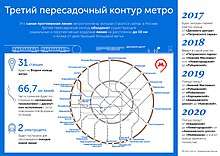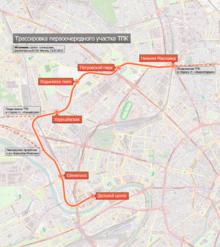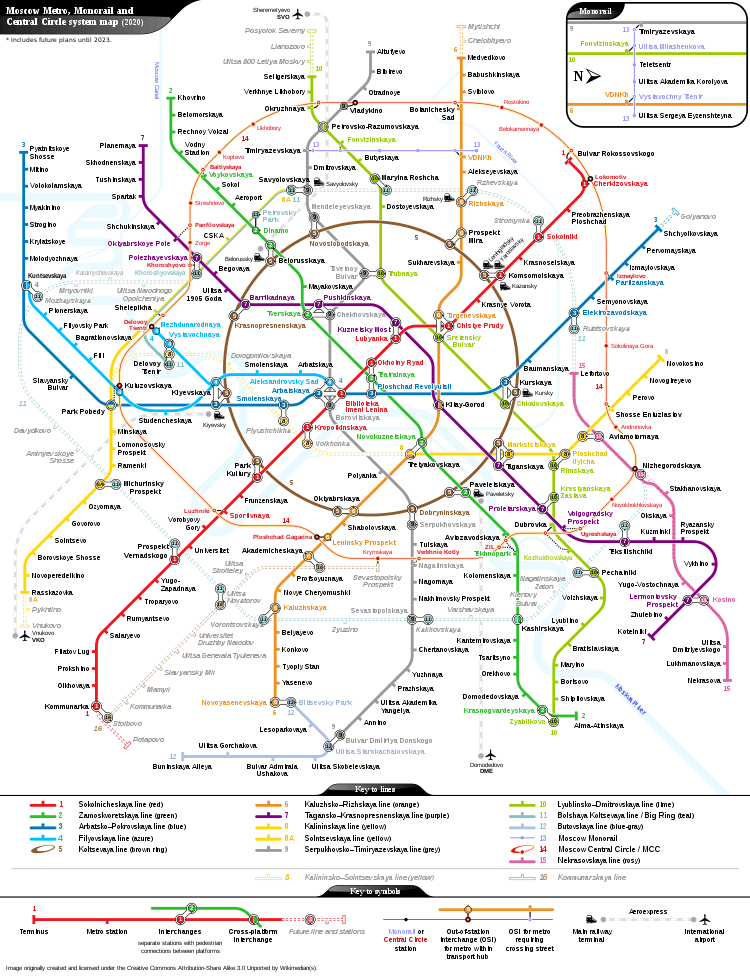Bolshaya Koltsevaya line
The Bolshaya Koltsevaya line (Russian: Большая кольцевая линия), literally Large Circle Line, designated Line 11[2] is a rapid transit line of the Moscow Metro. It is the third circle line running outside of the existing circle Koltsevaya line and interlocking Moscow Central Circle, with a temporary branch to Delovoy Tsentr station in Moscow International Business Center.
.svg.png) Geographic map showing the approximate path of the Bolshaya Koltsevaya line (in teal) in the whole Moscow Metro network (in dark gray) including Central Circle and Monorail | ||||||||||||||||||||||||||||||||||||||||||||||||||||||||||||||||||||||||||||||||||||||||||||||||||||||||||||||||||||||||||||||||||||||||||||||||||||||||||||||||||||||||||||||||||||||||||||||||||||||||||||||||||||||||||||||||||||||||||||||||||||||||||||||||||||||||||||||||||||||||||||||
| Overview | ||||||||||||||||||||||||||||||||||||||||||||||||||||||||||||||||||||||||||||||||||||||||||||||||||||||||||||||||||||||||||||||||||||||||||||||||||||||||||||||||||||||||||||||||||||||||||||||||||||||||||||||||||||||||||||||||||||||||||||||||||||||||||||||||||||||||||||||||||||||||||||||
| Other name(s) | Large Circle Line | |||||||||||||||||||||||||||||||||||||||||||||||||||||||||||||||||||||||||||||||||||||||||||||||||||||||||||||||||||||||||||||||||||||||||||||||||||||||||||||||||||||||||||||||||||||||||||||||||||||||||||||||||||||||||||||||||||||||||||||||||||||||||||||||||||||||||||||||||||||||||||||
| Native name | Большая Кольцевая линия | |||||||||||||||||||||||||||||||||||||||||||||||||||||||||||||||||||||||||||||||||||||||||||||||||||||||||||||||||||||||||||||||||||||||||||||||||||||||||||||||||||||||||||||||||||||||||||||||||||||||||||||||||||||||||||||||||||||||||||||||||||||||||||||||||||||||||||||||||||||||||||||
| Type | Rapid transit | |||||||||||||||||||||||||||||||||||||||||||||||||||||||||||||||||||||||||||||||||||||||||||||||||||||||||||||||||||||||||||||||||||||||||||||||||||||||||||||||||||||||||||||||||||||||||||||||||||||||||||||||||||||||||||||||||||||||||||||||||||||||||||||||||||||||||||||||||||||||||||||
| System | Moscow Metro | |||||||||||||||||||||||||||||||||||||||||||||||||||||||||||||||||||||||||||||||||||||||||||||||||||||||||||||||||||||||||||||||||||||||||||||||||||||||||||||||||||||||||||||||||||||||||||||||||||||||||||||||||||||||||||||||||||||||||||||||||||||||||||||||||||||||||||||||||||||||||||||
| Locale | Moscow | |||||||||||||||||||||||||||||||||||||||||||||||||||||||||||||||||||||||||||||||||||||||||||||||||||||||||||||||||||||||||||||||||||||||||||||||||||||||||||||||||||||||||||||||||||||||||||||||||||||||||||||||||||||||||||||||||||||||||||||||||||||||||||||||||||||||||||||||||||||||||||||
| Stations | 31 | |||||||||||||||||||||||||||||||||||||||||||||||||||||||||||||||||||||||||||||||||||||||||||||||||||||||||||||||||||||||||||||||||||||||||||||||||||||||||||||||||||||||||||||||||||||||||||||||||||||||||||||||||||||||||||||||||||||||||||||||||||||||||||||||||||||||||||||||||||||||||||||
| Operation | ||||||||||||||||||||||||||||||||||||||||||||||||||||||||||||||||||||||||||||||||||||||||||||||||||||||||||||||||||||||||||||||||||||||||||||||||||||||||||||||||||||||||||||||||||||||||||||||||||||||||||||||||||||||||||||||||||||||||||||||||||||||||||||||||||||||||||||||||||||||||||||||
| Opened | 11 August 1969 ( 26 February 2018 ( | |||||||||||||||||||||||||||||||||||||||||||||||||||||||||||||||||||||||||||||||||||||||||||||||||||||||||||||||||||||||||||||||||||||||||||||||||||||||||||||||||||||||||||||||||||||||||||||||||||||||||||||||||||||||||||||||||||||||||||||||||||||||||||||||||||||||||||||||||||||||||||||
| Operator(s) | Moskovsky Metropoliten | |||||||||||||||||||||||||||||||||||||||||||||||||||||||||||||||||||||||||||||||||||||||||||||||||||||||||||||||||||||||||||||||||||||||||||||||||||||||||||||||||||||||||||||||||||||||||||||||||||||||||||||||||||||||||||||||||||||||||||||||||||||||||||||||||||||||||||||||||||||||||||||
| Character | Underground | |||||||||||||||||||||||||||||||||||||||||||||||||||||||||||||||||||||||||||||||||||||||||||||||||||||||||||||||||||||||||||||||||||||||||||||||||||||||||||||||||||||||||||||||||||||||||||||||||||||||||||||||||||||||||||||||||||||||||||||||||||||||||||||||||||||||||||||||||||||||||||||
| Rolling stock | 81-760/761 81-760A/761A/763A 81-765.3/766.3/767.3 81-765.4/766.4/767.4 | |||||||||||||||||||||||||||||||||||||||||||||||||||||||||||||||||||||||||||||||||||||||||||||||||||||||||||||||||||||||||||||||||||||||||||||||||||||||||||||||||||||||||||||||||||||||||||||||||||||||||||||||||||||||||||||||||||||||||||||||||||||||||||||||||||||||||||||||||||||||||||||
| Technical | ||||||||||||||||||||||||||||||||||||||||||||||||||||||||||||||||||||||||||||||||||||||||||||||||||||||||||||||||||||||||||||||||||||||||||||||||||||||||||||||||||||||||||||||||||||||||||||||||||||||||||||||||||||||||||||||||||||||||||||||||||||||||||||||||||||||||||||||||||||||||||||||
| Line length | 69 kilometres (43 mi)[1] | |||||||||||||||||||||||||||||||||||||||||||||||||||||||||||||||||||||||||||||||||||||||||||||||||||||||||||||||||||||||||||||||||||||||||||||||||||||||||||||||||||||||||||||||||||||||||||||||||||||||||||||||||||||||||||||||||||||||||||||||||||||||||||||||||||||||||||||||||||||||||||||
| Track gauge | 1,520 mm (4 ft 11 27⁄32 in) | |||||||||||||||||||||||||||||||||||||||||||||||||||||||||||||||||||||||||||||||||||||||||||||||||||||||||||||||||||||||||||||||||||||||||||||||||||||||||||||||||||||||||||||||||||||||||||||||||||||||||||||||||||||||||||||||||||||||||||||||||||||||||||||||||||||||||||||||||||||||||||||
| Electrification | Third rail | |||||||||||||||||||||||||||||||||||||||||||||||||||||||||||||||||||||||||||||||||||||||||||||||||||||||||||||||||||||||||||||||||||||||||||||||||||||||||||||||||||||||||||||||||||||||||||||||||||||||||||||||||||||||||||||||||||||||||||||||||||||||||||||||||||||||||||||||||||||||||||||
| ||||||||||||||||||||||||||||||||||||||||||||||||||||||||||||||||||||||||||||||||||||||||||||||||||||||||||||||||||||||||||||||||||||||||||||||||||||||||||||||||||||||||||||||||||||||||||||||||||||||||||||||||||||||||||||||||||||||||||||||||||||||||||||||||||||||||||||||||||||||||||||||
The first section of the line opened on 26 February 2018 with expected completion of the final stage in 2022. When complete, the line will include 31 stations including three from the existing Kakhovskaya line and over 66 kilometers of track. In November 2017 the city estimated the total cost of the project at 501 billion rubles, up from earlier estimates of 378.9 billion rubles.[3]
Formerly known as the Third Interchange Contour, the city adopted "Large Circle Line" as the official name of the line after a vote via the "Active Citizen" web portal.[4]
Name
The working name of the project since inception was the Third Interchange Contour; however, prior to the opening of the line, the city of Moscow reached out to its residents to help decide on the name. In an initial survey on the Active Citizen survey website in October 2017, only 34% of the city’s residents voted to keep the working name.[5]
Although retaining the working name was the most popular option, members of the city’s council on transportation infrastructure suggested another vote. Two reasons cited by Kirill Yankov were that all of the line’s names to this point were in the feminine grammatical gender and that all the other line names were generally understood from a point of view of geography.[6] The city held another vote on its website to allow citizens to choose between the existing name or the Bolshaya Koltsevaya line (Large Circle Line). Of the alternate names suggested by voters in the first vote, Bolshaya Koltsevaya was the most popular, with 9,000 votes.
In the second vote, Bolshaya Koltsevaya was selected with 53.3% of the votes versus 36.5% for the Third Interchange Contour.[4]
Development

The entire project was supposed to be completed by 2020–2021.[1][7][8][9][10] By 2018, the completion date had been postponed until the end of 2022.[11]
First sections

The five stations from Petrovsky Park to Delovoy Tsentr opened on 26 February 2018.[12] Savyolovskaya was opened on 30 December 2018.
Further extension
The northeastern section was initially scheduled to be completed in 2018 and was opened on 27 March 2020. This section includes the part of the line from Elektrozavodskaya to Nizhegorodskaya.[13] The existing, short, three-station Kakhovskaya line will be incorporated into the line.
The original plans called for a 58-kilometer line with 27 new stations.[14]
Maps
 schematic inc. MCC
schematic inc. MCC true location, no MCC (outdated scheme)
true location, no MCC (outdated scheme)
References
- "Третий пересадочный контур". Moscow Complex for Urban Development and Construction. Retrieved 2017-10-20.
- Scheme Moscow Metro
- "Строительство второго кольца метро подорожало до 500 млрд руб". RBC. 2017-11-23.
- "Большая кольцевая линия: «активные граждане» выбрали название для новой ветки метро" (in Russian). City of Moscow. 2017-12-28.
- "За название для Третьего пересадочного контура метро проголосовали больше 280 тысяч человек" (in Russian). City of Noscow. 2017-10-08.
- "Название Третьего пересадочного контура определит новый этап голосования" (in Russian). TASS. 2017-12-11.
- "New Metro Ring Line On Track for 2018 | Business". The Moscow Times. Retrieved 2015-11-01.
- "Метро". stroi.mos.ru. Retrieved 2015-11-01.
- "Метро до «Нижней Масловки» дойдет в 2018 году". tripsmile.ru (in Russian). Retrieved 2019-01-28.
- "Пять станций Второго кольца метро могут открыть в 2017 году – Бочкарев". stroi.mos.ru (in Russian). Retrieved 2019-01-28.
- "Большая кольцевая линия московского метро замкнется в 2022 году". mosday.ru (in Russian). Retrieved 2019-01-28.
- "Запуск Третьего пересадочного контура перенесли на следующий год" (in Russian). Вести. 2017-12-18.
- "Марат Хуснуллин: Кожуховская ветка метро разгрузит Таганско-Краснопресненскую линию". Vechernyaya Moskva. Retrieved 2014-03-10.
- 30 километров тоннелей Второго кольца метро будут двухпутными (in Russian). Moscow Complex of City Planning Policies and Construction. 2014-08-21. Retrieved 2014-11-24.
External links
| Wikimedia Commons has media related to Bolshaya Koltsevaya Line. |